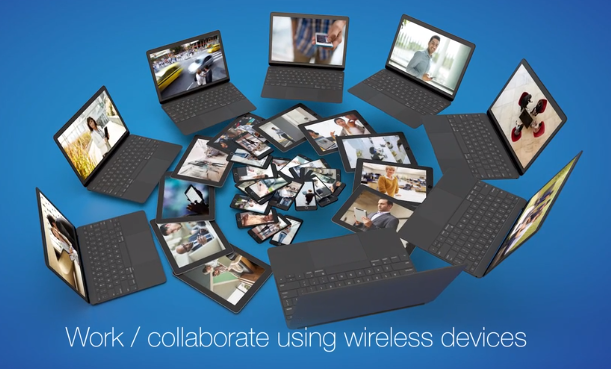June 25, 2019 by Siobhan Climer
The release of 802.11ax – or Wi-Fi 6 – marks a swift shift in wireless networking. It is, theoretically, dramatically faster than Wi-Fi 5, offering the same basic service – Internet connectivity – at 9.6 Gbps (that’s 3.5 Gbps faster than Wi-Fi 5).
 The rise of the Internet of Things (IoT), the increase in cloud-based applications, and the implementation of BYOD (Bring Your Own Device) policies at businesses around the world means a huge increase in the number of devices connecting to the network. Wi-Fi 6’s increase in speed will enable improved network connectivity for all those devices vying for network juice.
The rise of the Internet of Things (IoT), the increase in cloud-based applications, and the implementation of BYOD (Bring Your Own Device) policies at businesses around the world means a huge increase in the number of devices connecting to the network. Wi-Fi 6’s increase in speed will enable improved network connectivity for all those devices vying for network juice.
But Wi-Fi 6 only solves part of the problem. While Wi-Fi 6 providers higher bandwidth, the total wired infrastructure capacity will still be overloaded with more traffic per Access Point. That’s the benefit of multigigabit technology, which will increase network speed and traffic without requiring a complete legacy wiring infrastructure replacement.
What Is Multigigabit Technology?
The risk of the wired network causing a performance bottleneck increased enough to spur the development of multigigabit technology, which allows you to achieve bandwidth between 1 and 10 Gbps over traditional Cat 5e cabling. This essentially enables you to extend the life of your current wired infrastructure.
While gigabit technology has been around for almost two decades, recent growth of bandwidth-intensive applications and the IoT means some businesses are finally reaching their bandwidth thresholds.
How Multigigabit Technology Works
Multigigabit technology, developed in conjunction with the NBASE-T Alliance, uses the current Cat 5e or Cat 6 twisted cable to deliver 2.5G or 5G – or even 10G.
Here’s a great video by Cisco describing how multigigabit technology works:
Benefits Of A Move To Multigigabit Technology Ethernet
One of the biggest benefits of multigigabit technology is the added ROI you gain from your current infrastructure. Typically, to achieve the 10 Gbps growing networks demand, you would need to do a complete rip and replace of the entire wired infrastructure. You don’t need us to tell you how expensive that is.
Multigigabit technology allows you to achieve the same high speeds and connectivity without this enormous capital expenditure.
Despite the fact that Wi-Fi 6 isn’t likely impacting your environment yet (while it enables almost 10 Gbps, the Verge notes a typical download speed in the US is just 72 Mbps), the rate of adoption in the industry means it will do so soon.
Infrastructure Optimization: Start By Knowing
Implementing multigigabit technology is part of a broader strategy to optimize infrastructure. Begin with an infrastructure optimization assessment to learn how to best optimize your current environment for your real business needs.
Prepare For Wi-Fi 6 Today
Prepare for the needs of tomorrow’s network today with the implementation of multigigabit technology. Talk with our experts about the needs of your network and how we can help you achieve your business goals in our weekly whiteboard sessions.
Like what you read?
Contact us today to discuss multigigabit technology.
About Mindsight
Mindsight, a Chicago IT services provider, is an extension of your team. Our culture is built on transparency and trust, and our team is made up of extraordinary people – the kinds of people you would hire. We have one of the largest expert-level engineering teams delivering the full spectrum of IT services and solutions, from cloud to infrastructure, collaboration to contact center. Our highly-certified engineers and process-oriented excellence have certainly been key to our success. But what really sets us apart is our straightforward and honest approach to every conversation, whether it is for an emerging business or global enterprise. Our customers rely on our thought leadership, responsiveness, and dedication to solving their toughest technology challenges.
Contact us at GoMindsight.com.
About The Author
Siobhan Climer, Science and Technology Writer for Mindsight, writes about technology trends in education, healthcare, and business. She previously taught STEM programs in elementary classrooms and museums, and writes extensively about cybersecurity, disaster recovery, cloud services, backups, data storage, network infrastructure, and the contact center. When she’s not writing tech, she’s writing fantasy, gardening, and exploring the world with her twin two-year old daughters. Find her on twitter @techtalksio.



